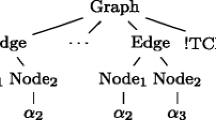Abstract
XML documents may be roughly described as unranked, ordered trees and it is therefore natural to use tree automata to process or validate them. This idea has already been successfully applied in the context of Document Type Definition (DTD), the simplest standard for defining document validity, but additional work is needed to take into account XML Schema, a more advanced standard, for which regular tree automata are not satisfactory. In this paper, we introduce Sheaves Logic (SL), a new tree logic that extends the syntax of the – recursion-free fragment of – W3C XML Schema Definition Language (WXS). Then, we define a new class of automata for unranked trees that provides decision procedures for the basic questions about SL: model-checking; satisfiability; entailment. The same class of automata is also used to answer basic questions about WXS, including recursive schemas: decidability of type-checking documents; testing the emptiness of schemas; testing that a schema subsumes another one.
Similar content being viewed by others
References
Abiteboul S., Buneman P., Suciu D. (1999) Data on the Web: From Relations to Semistructured Data and XML. Morgan Kaufmann, San Francisco CA
Berlea A., Seidl H.: Binary queries. Extreme Markup Languages (2002)
Brown A., Fuchs M., Robie J., Wadler P. MSL: A model for W3C XML Schema. WWW 10 (2001)
Cardelli L., Gordon A. (2000) Anytime, anywhere: Modal logic for mobile ambients Principles of Programming Languages (POPL). ACM Press, New York
Cardelli L., Ghelli G.: A query language based on the ambient logic. In: European Symposium on Programming (ESOP), LNCS vol. 2028, pp. 1–22. Springer, Berlin Heidelberg New York (2001)
Clark J., Makoto M. (eds): RELAX-NG Tutorial. OASIS, 2001
Colcombet T.: Rewriting in the partial algebra of typed terms modulo AC. Electron. Notes Theor. Comput. Sci. 68 (2002)
Comon H., Dauchet M., Jacquemard F., Tison S., Lugiez D., Tommasi M.: Tree Automata on their application. Available at http://www.grappa.univ-lille3.fr/tata/ (1999)
Courcelle B. (1990) The monadic second-order logic of graphs. I. Recognizable sets of finite graphs. Inform. Comput. 85, 12–75
Klaedtke F., Ruess H.: Monadic Second-order Logics with Cardinalities. In International Colloquium on Automata, Languages and Programming (ICALP), LNCS vol. 2719, pp. 681–696. Springer (2003)
Kupferman O., Sattler U., Vardi M.: The complexity of the graded μ-calculus. In: International Conference on Automated Deduction (CADE), LNCS vol. 2392, pp. 423–437. Springer, Berlin Heidelberg New York (2002)
Dal Zilio S., Lugiez D.: XML schema, tree logic and sheaves automata. Technical Report 4631, INRIA (2002)
Dal Zilio S., Lugiez D., Meyssonnier C.: A logic you can count on. Principles of Programming Languages (POPL), pp. 135–146. ACM Press, New York (2004)
Fischer M., Rabin M.O.: Super-exponential complexity of Presburger arithmetic. In: SIAM-AMS Symposium in Applied Mathematics, vol. 7, pp. 27–41 (1974)
Hosoya H., Pierce B.C.: Regular expression pattern matching for XML. In: Principles of Programming Languages (POPL), pp. 67–80. ACM Press, New York (2001)
Lugiez D. (2005) Multitree automata that count. Theor. Comput. Sci. 333, 225–263
Lugiez D., Moysset J.L. (1994) Tree automata help one to solve equational formulae in AC-theories. J. Symbol. Comput. 18(4): 297–318
Lugiez D., Dal Zilio S.: Multitrees automata, Presburger’s constraints and tree logics. Technical Report 08-2002, LIF (2002)
Murata M.: DTD transformation by patterns and contextual conditions. SGML/XML. GCA (1997)
Murata M.: Extended path expression for XML. Principles of Database Systems (PODS). ACM Press, New York (2001)
Muscholl A., Schwentick T., Seidl H.: Numerical document queries. Principle of Databases Systems (PODS). ACM Press, New York (2003)
Neven F., Schwentick T. (2002) Query automata on finite trees. Theor. Comput. Sci. 275, 633–674
Neven F.: Automata theory for XML researchers. Sigmod Rec. 31(3) (2002)
Niehren J., Podelski A.: Feature automata and recognizable sets of feature trees. TAPSOFT, LNCS, vol. 668, pp. 356–375. Springer, Berlin Heidelberg New York (1993)
Ohsaki H.: Beyond the regularity: equational tree automata for associative and commutative theories. In: International Workshop on Computer Science Logic (CSL), LNCS, vol. 2142, pp. 539–553. Springer, Berlin Heidelberg New York (2001)
Oppen D.C. (1978) A \(2^{2^{2^{pn}}}\) upper bound on the complexity of Presburger arithmetic. J. Comput. Syst. Sci. 16, 323–332
Pair C., Quéré A. (1968) Définition et étude des bilangages réguliers. Inform. Control 13(6): 565–593
Seidl H., Muscholl A., Schwentick T., Habermehl P.: Counting in trees for free. In: Proceedings 31st International Colloquium on Automata, Languages, and Programming (ICALP), LNCS, vol. 3142, pp. 1136–1149. Springer, Berlin Heidelberg New York (2004)
Thatcher J.W. (1967) Characterizing derivation trees of context-free grammars through a generalization of automata theory. J. Comput. Sys. Sci. 1, 317–322
Thatcher J.W., Wright J.B. (1968) Generalized finite automata with an application to a decision problem of second-order logic. Math. Syst. Theory 2, 57–82
Author information
Authors and Affiliations
Corresponding author
Additional information
This work was partially supported by the French government research grant ACI TRALALA and by IST Global Computing Profundis.
Rights and permissions
About this article
Cite this article
Zilio, S.D., Lugiez, D. XML schema, tree logic and sheaves automata. AAECC 17, 337–377 (2006). https://doi.org/10.1007/s00200-006-0016-7
Received:
Revised:
Published:
Issue Date:
DOI: https://doi.org/10.1007/s00200-006-0016-7




